Dianthus: All You Need To Know When Growing Carnations Or Garden Pinks

PERENNIALS > DIANTHUS
Reviewed By DAN ORI

Dan has over 27 years’ under his belt caring for plants and gardens. Working as a Horticultural Instructor and Consultant, he draws on a diverse range of experience that includes working as a Head Gardener, Tree Surgeon, Garden Centre Trouble Shooter, and writer of academic papers. Dan has a Level 3 Diploma in Horticulture and is currently a candidate for the RHS’s most prestigious award – The Master of Horticulture.
IN THIS GUIDE
Dianthus, the ‘Flower of the Gods’, was as admired in Ancient Greece as it is in Modern England, and for good reasons.
The double, ruffled blooms with their fringed or frilly edges are unique, and exhibit colours from palest pink to maroon-black.
Reputed as ideally suited for cottage gardens, it is fair to ask whether this wonderful genus is not ideally suited for any garden.
Overview
| Botanical Name | Dianthus |
| Common Name(s) | Carnation, Pinks, Sweet William |
| Plant Type | Perennial (some annuals) |
| Native Area | Southern Europe |
| Hardiness Rating | H6 / H7 |
| Foliage | Evergreen or deciduous |
| Flowers | Showy, often fragrant flowers |
| When To Sow | March, April, May, June, July, August, September, October |
| Flowering Months | May, June, July, August, September, October |
| When To Prune | October, November |
Sunlight
Preferred
Mostly Full Sun
Exposure
Sheltered
Size
Height
0.1 – 0.5M
Spread
0.1 – 0.5M
Bloom Time
May – October
Soil
Preferred
Most Fertile Soils
Moisture
Well Drained
pH
Any
Dianthus is quite a fascinating genus of flowering herbaceous plants: though it encompasses a fair number of species totalling around 380, much of the ‘press’ and interest surrounds only three of those species – and those three species include untold thousands of cultivars.1Fassou, G., Korotkova, N., Nersesyan, A., Koch, M. A., Dimopoulos, P., & Borsch, T. (2022, May 23). Taxonomy of Dianthus (Caryophyllaceae) – overall phylogenetic relationships and assessment of species diversity based on a first comprehensive checklist of the genus. PhytoKeys; Pensoft Publishers. https://doi.org/10.3897/phytokeys.196.77940
These three garden favourites are D. caryophyllus commonly known as Carnations, D. plumarius, colloquially called Garden Pinks, and D. barbatus, usually termed Sweet Williams.

The vast majority of cultivars of interest are evergreen perennials.
The ruffly, frilly flowers come in white, yellow, pink, red, and mauve in a remarkable range of hues from palest pastel to rich and intense.
Moreover, many cultivars’ flowers are bicoloured, exhibiting feathering, edging, or flecks.
They are marked by a somewhat unusual feature: the distal end of most varieties’ petals are fringed, serrated or even toothed.
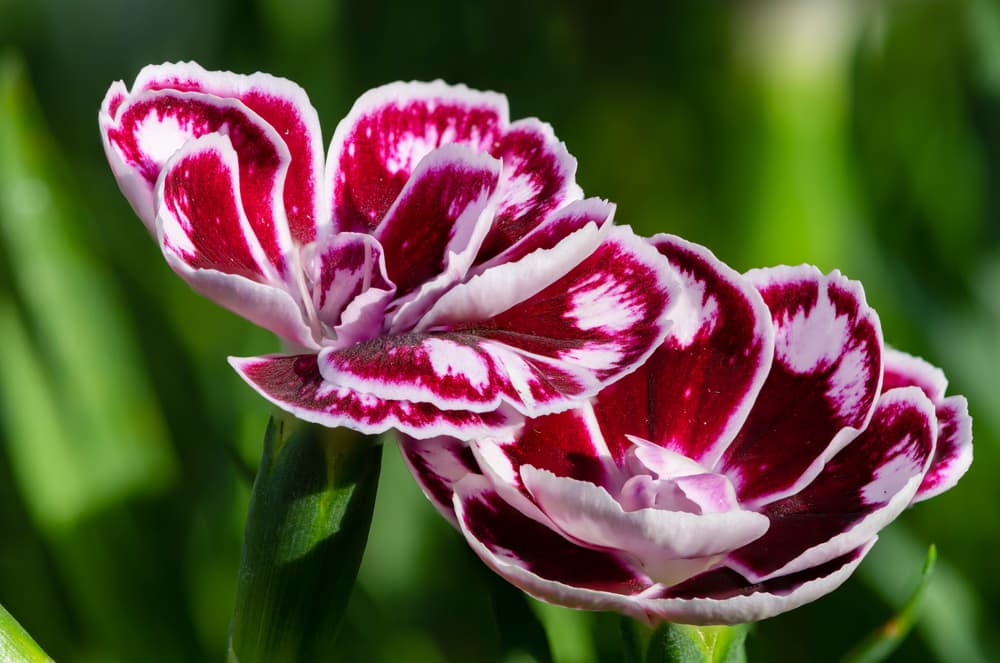
All carnations have double or semi-double flowers and most garden pinks are double while a few are single.
Another quirky attribute carnations and garden pinks, particularly the latter, have is their scent.
While some are unscented, and others are moderately scented, many exude a thick, sweet fragrance redolent of cloves or cinnamon.
Carnations

Carnations are divided into perpetual flowering or exhibition carnations, border carnations, and pot carnations.
The former bloom year-round and are cultivated in greenhouses for exhibiting and floriculture.
The latter are compact evergreens to about 25cm and often have semi-double flowers.
Border carnations are the ones with which most of us are familiar; these have a bushy, erect habit, are 50cm or more, and have full double flowers.
These plants are also typed by the size of their bloom and by whether there is a single flower or a spray.
Though all Dianthus cultivars provide excellent cut flowers, carnations are much valued by florists as they stay ‘fresher than a daisy’ in bouquets and are remarkably long-lasting in vases.
Garden Pinks

Yet between carnations, sweet williams, and garden pinks, it is the last-named that runs away with the popularity prize – garden pinks are British gardeners’ favourite Dianthus.
Like carnations, pinks are also divided into types, but they descend from different species.
Besides garden pinks, there are cheddar pinks and China pinks; the former are cultivars of D. gratianopolitanus, and the latter of D. chinensis.
Pinks are named as such because their petals look as if they were cut by a tailor’s decorative pinking scissors which leaves a zig-zag edge.
Habitat & Growing Conditions
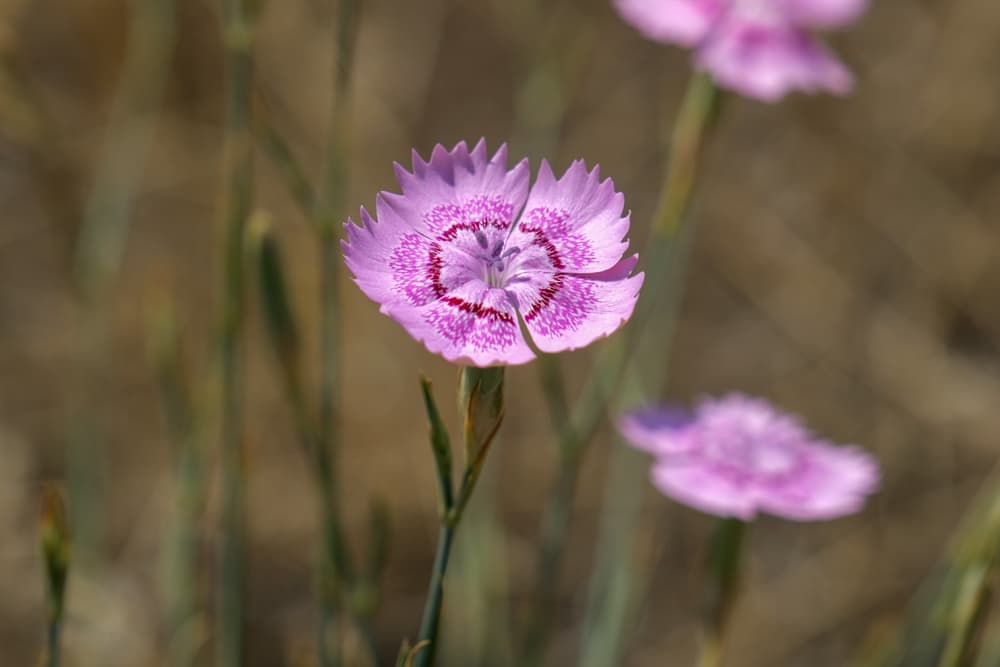
Dianthus species occur in nature in extensive geographical regions and climatic zones.
They are found in the heat of India and Northern Africa to the northernmost reaches of Russia.
They grow in fields, woodlands, steppes, hillsides, and taiga.
The various species’ hardiness varies from Hardiness Zones Sub-H7 to H3.
Nearly all the popular cultivars are hardy to H6.
Perpetual flowering carnations are not hardy being suitable only to H2, which is why they are grown in greenhouses.
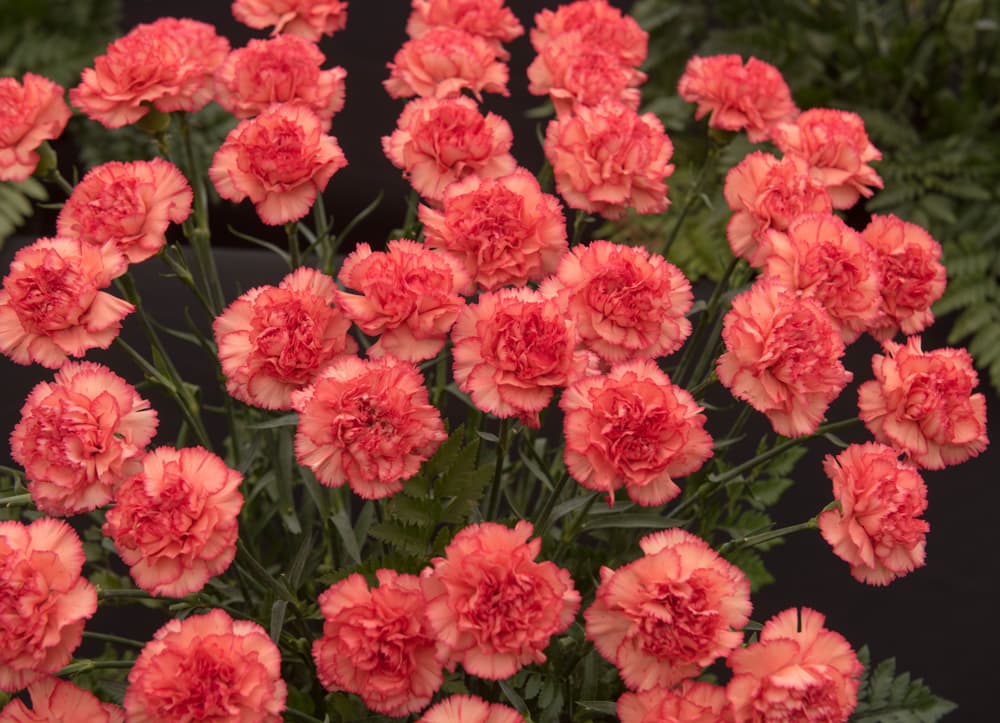
The varieties’ heat tolerance varies too. In general, various pinks and sweet Williams are more heat tolerant than carnations.
D. caryophyllus, a carnation, originates from the Mediterranean region including Italy and Greece.
Though D. plumarius, garden pink, is native to Central Europe, it has colonised several regions of the United States where it is classified as an invasive species.
D. barbatus, sweet William, is from Southern Europe, growing in nature in a belt of land from Spain to Hungary and Romania.
It exhibits a preference for hillsides and hilly areas.
Planting Dianthus
The heights, habits, blooms, and colours of Dianthus varieties make these evergreens excellent choices for all purposes from edging a walkway to the middle rows in a mixed bed.
Dwarf pinks which grow to 20-30cm are ideal for rock gardens and edging.
Pink ‘Pixie Star’ and pink ‘Dainty Dame’ are excellent examples. Mat-forming cheddar pinks are just as excellent for such purposes.
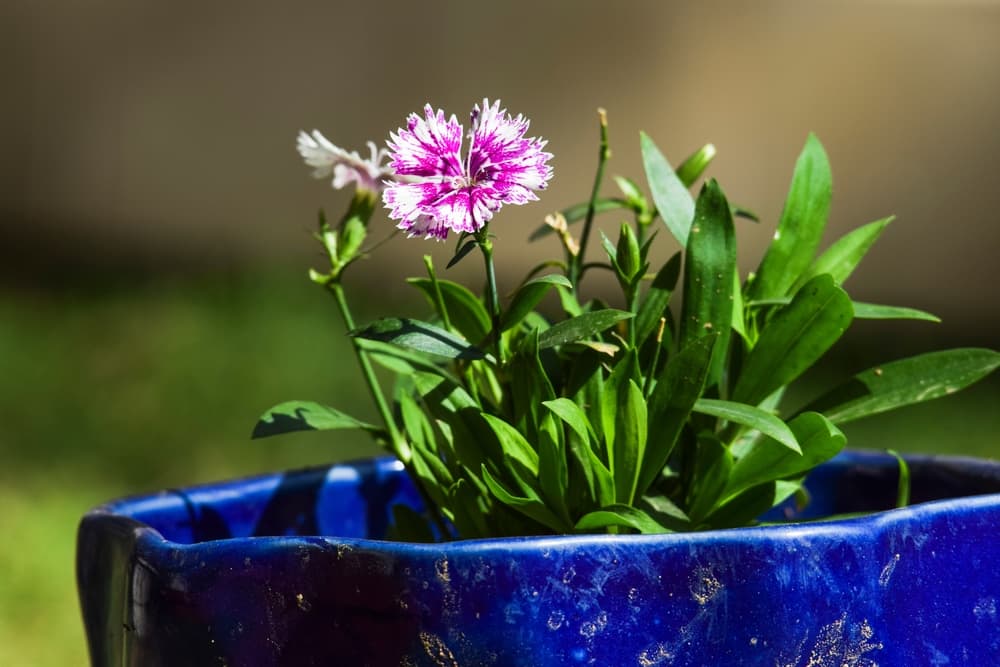
These types of dwarf evergreens are also top choices for groundcover.
Border carnations attain heights from 50-75cm. Though, in general, they have a bushy habit, they can be pruned for a more columnar form.
If this is done many cultivars will require staking, while some require staking anyway.
They are perfect for the middle of a bed or even the rear of a narrow bed.
Some varieties offer the height, habit and striking bloom to be set out in pots.

Carnation ‘Leon Tautz’ and carnation ‘Jean Knight,’ among a few others, make fantastic specimen plants.
Midway between the two are garden pinks with a mounding habit and sweet Williams.
With heights falling between 30-60cm, they are great for the front of beds and borders, and also are very well suited as pot plants and container plants.
Examples include pink ‘Pinball Wizard,’ pink ‘Rhian’s Choice’ and sweet William ‘Auricula-Eyed Mixed’.
Plant Care & Growing Tips
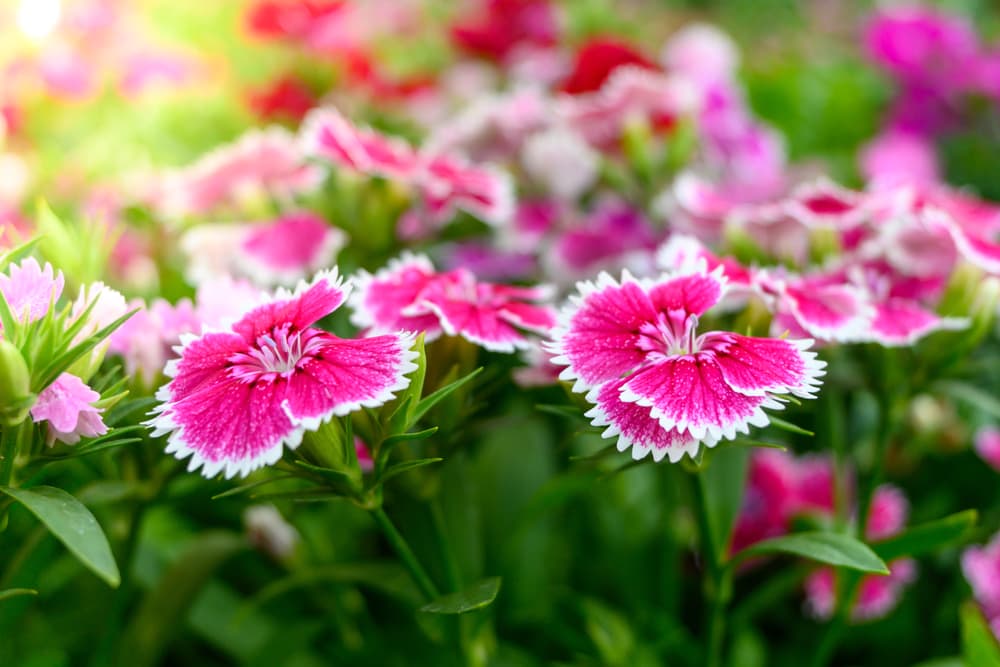
Considering that the Dianthus genus is quite large and, especially, the fact that a few species have been heavily cultivated for centuries, Dianthus plants respond very well to a single set of generalised gardening tips.
Soil Requirements
A light, clay-free, sandy, gravelly loam amended with peat moss or compost is ideal for these plants. The soil must be very well-drained.
Its pH should be moderately alkaline to slightly alkaline – 8.4 to 7.4.
Aspect
Plants may get full sun, or morning sun and filtered or dappled afternoon sun.
When transplanting, the soil level of each plant should be the same as it was in the tray or pot. Better a little too low than a little too high.
As for the spacing, this will depend on the habit and the spread of the variety in question.
Staking
Some carnation cultivars need support as they grow.
Stake them by enclosing the main stem with support canes and tying them around with twine.
Pruning
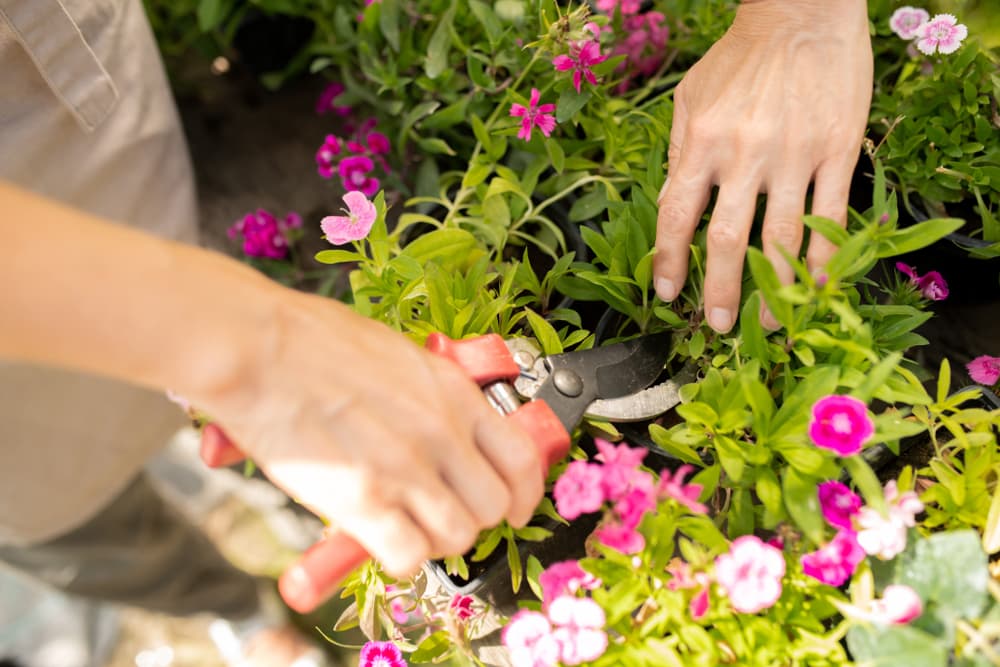
In order to encourage a bushy habit or mounding in young pinks, the leader is sometimes bent or pinched, and initial flowering is otherwise impeded until the plant develops a sufficient number of side shoots.
Disbudding is a method sometimes used in carnations though this is done to primarily influence targeted flowers and not the plant as a whole.
To maximise the size and quality of pre-selected carnation buds for blooming, you may choose to disbud others.
“Most Dianthus will make great cut flowers, just cut them and place them in a small vase,” says Master Horticulturist Peter Lickorish.
Sometimes, you may find they start to root in the water, so I would then trim off the flower and pot it up to grow on.”
Common Problems
Dianthus, more often carnations, can be affected by carnation rust, bacterial wilt, and fusarium wilt.
They are also subject to viral infections which cause carnation mottle, carnation etched ring, carnation ring spot and other diseases.
These each require specialised treatment.
Sourcing Dianthus

Carnation, garden pink, and sweet William varieties are among the easiest plants to find, with the perennial British favourite garden pink leading the pack.
Some or other varieties are available as potted plants in virtually every nursery and garden centre, while seed packets are equally easy to find.
In addition, you can get new Dianthus by layering and cuttings.
The somewhat more technical art of layering is usually used with carnations while softwood cuttings work well with both carnations and garden pinks.
References
- 1Fassou, G., Korotkova, N., Nersesyan, A., Koch, M. A., Dimopoulos, P., & Borsch, T. (2022, May 23). Taxonomy of Dianthus (Caryophyllaceae) – overall phylogenetic relationships and assessment of species diversity based on a first comprehensive checklist of the genus. PhytoKeys; Pensoft Publishers. https://doi.org/10.3897/phytokeys.196.77940

